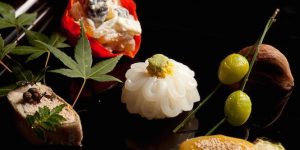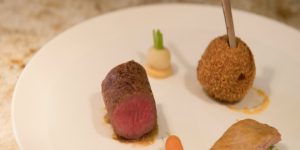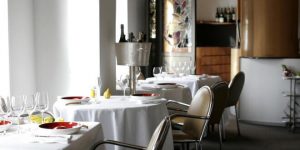Yokan Collection Singapore Edition 2017
An interview with Mr Mitsu Kurokawa, Managing Director of Toraya and the 18th generation’s maker of Wagashi (the traditional Japanese sweets), who flew down from Japan to debut the first Yokan Collection in Singapore

The first edition of Yokan Collection was unveiled at the National Museum of Singapore in October 2017. Over 100 types of yokan went on display and visitors to the exhibition could taste the sweets and also witness the beautiful creations of the yokan made by famous and skilled Japanese wagashi chefs.
Yokan is a collection of Japanese signature sweets that are enjoyed and well-loved by many in Japan. The delicacy can be savoured on its own, lightly taken between main meals or be paired with beverages such as green and black tea, champagne or wine to enhance the enjoyment of this traditional Japanese sweet. What makes a good yokan really depends on the right blend of key ingredients, the art of artisanal candy-making and also the artful presentations to keep up with the changing taste profiles of consumers.


During the preview, we managed to taste three types of yokans: Traditional Yokan matched with Matcha Tea, Steamed Yokan paired with Cold Sencha and the Seasonal Yokan with premium Cold Sencha. The more traditional yokans are made with very simple ingredients by blending Azuki red beans, agar and sugar to form a smooth paste.
The traditional yokan has a refreshing red bean flavour and a slight sweetness to it with a chewy texture. As for the seasonal yokans, the ingredients are used to create delicious pieces, aligned with the palette of the different seasons in Japan, only when they are prime and ripe for harvest.

We interviewed Mr Mitsu Kurokawa, Managing Director of Toraya and also the 18th generation’s maker of Wagashi (the traditional Japanese sweets), who flew down from Japan to debut the first Yokan Collection in Singapore.
We’ve witnessed the beauty of Yokan as well as the craft and refined tastes in Yokan. What else are you excited about?
This is the first edition of the Yokan Collection held at the National Museum of Singapore. We are very excited to bring a wide selection of signature sweets to Singapore, specially crafted by the Yokan shops from throughout Japan. Visitors can view the demonstrations of yokans and see how the sweets are made. As this event is funded by the Japanese government, we are pleased to promote the various Japanese brands and introduce our culture and tradition to the locals as well. You will see women dressed in traditional kimonos and we have also brought in a few popular Japanese teas to pair with the desserts and more. To inject some fun and creativity into the event, we put up a 3D video mapping to project the different types of yokans on a large wall.
What has been most challenging about bringing the taste of Yokan to Asia and what else can be done to attract more people to better appreciate the handmade Japanese sweets?
We hope that the yokan varieties are not too foreign for their liking and that the locals can adapt to the sweetness and flavours of the Japanese delicacies. Through this exhibition, Singaporeans will have a better idea of the culture and history of yokans. We are treating guests to a wide range of the artful yokans infused with exotic flavours and aromas of Asia, specially created by Japanese wagashi chefs. I really hope that Singaporeans will enjoy the best of gastronomic and cultural experience that Japan has to offer.
What is the overall strategy to reposition Toraya for the next century?
If you are talking about the next century, it means planning and strategising for the long-term. We need to think about keeping up with changes and coming up with solutions to move the brand forward and survive the next 100 years. Part of the strategies is to make the best sweets, improve on the recipes and refine the tastes to suit our consumer’s palate. My great grandfather had been making yokan from locally grown Azuki beans from the crop which he had cultivated with the locals many years ago. The red beans are still a very precious resource in Japan. Today, we are able to harvest the Azuki beans from the same crop and use them to support the production of our sweets. I am hoping to do something that can be beneficial to the industry, like growing Azuki beans in different parts of the world to meet the growing demands.









